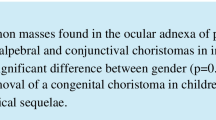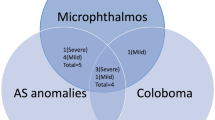Abstract
The aim of this study was to investigate the types and presentation pattern of congenital defects of the eye and adnexia in our center. This is a retrospective review of congenital defects of the eye and adnexia over a 20-month period at a tertiary referral center in Lagos, Nigeria. Records were analyzed for age at presentation, laterality, gender, vision assessment, and type(s) of abnormality. Out of 412 pediatric patients, 40 (9.7 %) were seen to have congenital abnormality of the eye and/or its adnexia during the study period. There were 17 (42.5 %) males. Twelve patients (30.0 %) presented with involvement of the right eyes, nine (22.5 %) with left eyes, while 19 (47.5 %) had bilateral involvement. Twenty-eight patients (70.0 %) were aged 1 year or less at the time of presentation. A total of 69 entities were recognized as some children had two or more malformations. The common congenital defects identified were cataract (39.1 %), ptosis (17.4 %), glaucoma (8.7 %), and cornea opacity (7.2 %). Other less common congenital defects include: microphthalmos, anophthalmos, coloboma (lid and iris), dermoid cyst, and aniridia. All of the patients with available visual acuity documentation had visual impairment. A high proportion of the patients were lost to follow-up. Cataract, ptosis, and glaucoma were the commonest congenital defects of the eye and adnexia in our center and were associated with visual impairments. The significant loss of the patients during follow-up needs urgent investigation and attention to forestall this trend.




Similar content being viewed by others
References
Hornby SJ, Gilbert CE, Rahi JK, Sil AK, Xiao Y, Dandona L, Foster A (2000) Regional variation in blindness in children due to microphthalmos, anophthalmos and coloboma. Ophthalmic Epidemiol 7:127–138
Levin AV (2003) Congenital eye anomalies. Pediatr Clin North Am 50:55–76
Guercio JR, Martyn LJ (2007) Congenital malformations of the eye and orbit. Otolaryngol Clin North Am 40:113–140 vii
Francis PJ, Moore AT (2004) Genetics of childhood cataract. Curr Opin Ophthalmol 15:10–15
Morrison D, FitzPatrick D, Hanson I, Williamson K, van Heyningen V, Fleck B, Jones I, Chalmers J, Campbell H (2002) National study of microphthalmia, anophthalmia, and coloboma (MAC) in Scotland: investigation of genetic aetiology. J Med Genet 39:16–22
Shah SP, Taylor AE, Sowden JC, Ragge NK, Russell-Eggitt I, Rahi JS, Gilbert CE (2011) Anophthalmos, microphthalmos, and typical coloboma in the United Kingdom: a prospective study of incidence and risk. Invest Ophthalmol Vis Sci 52:558–564
Bodunde OT, Ajibode HA (2006) Congenital eye diseases at Olabisi Onabanjo University Teaching Hospital, Sagamu, Nigeria. Niger J Med 15:291–294
Chuka-Okosa CM, Magulike NO, Onyekonwu GC (2005) Congenital eye anomalies in Enugu, South-Eastern Nigeria. West Afr J Med 24:112–114
Lawan A (2008) Congenital eye and adnexal anomalies in Kano, a five year review. Niger J Med 17:37–39
Lagos State Government (2010) The Official website of Lagos State. http://www.lagosstate.gov.ng/pagelinks.php?p=6. Accessed 28 Nov 28 2013
United Nations Country Profile. http://data.un.org/CountryProfile.aspx?crName=NIGERIA. Accessed 4 Jan 2014
Forrester MB, Merz RD (2006) Descriptive epidemiology of anophthalmia and microphthalmia, Hawaii, 1986–2001. Birth Defects Res A Clin Mol Teratol 76:187–192
Kallen B, Robert E, Harris J (1996) The descriptive epidemiology of anophthalmia and microphthalmia. Int J Epidemiol 25:1009–1016
Riano Galan I, Rodriguez Dehli C, Garcia Lopez E, Moro Bayon C, Suarez Menendez E, Ariza Hevia F, Mosquera Tenreiro C (2010) Frequency and clinical presentation of congenital ocular anomalies in Asturias 1990–2004. An Pediatr (Barc) 72:250–256
Bermejo E, Martínez-Frías M-L (1998) Congenital eye malformations: clinical-epidemiological analysis of 1,124,654 consecutive births in Spain. Am J Med Genet 75:497–504
Eballe AO, Ellong A, Koki G, Nanfack NC, Dohvoma VA, Mvogo CE (2012) Eye malformations in Cameroonian children: a clinical survey. Clin Ophthalmol 6:1607–1611
Zhu J, Wang Y, Zhou G, Liang J, Dai L (2000) A descriptive epidemiological investigation of anophthalmos and microphthalmos in China during 1988–1992. Zhonghua Yan Ke Za Zhi 36:141–144
Papadopoulos M, Cable N, Rahi J, Khaw PT (2007) The British Infantile and Childhood Glaucoma (BIG) Eye Study. Invest Ophthalmol Vis Sci 48:4100–4106
Ionides A, Francis P, Berry V, Mackay D, Bhattacharya S, Shiels A, Moore A (1999) Clinical and genetic heterogeneity in autosomal dominant congenital cataract. Br J Ophthalmol 83:802–808
Bowman RJ (2005) How should blindness in children be managed? Eye 19:1037–1043
Allard FD, Durairaj VD (2010) Current techniques in surgical correction of congenital ptosis. Middle East Afr J Ophthalmol 17:129–133
Skaat A, Fabian D, Spierer A, Rosen N, Rosner M, Ben Simon GJ (2013) Congenital ptosis repair-surgical, cosmetic, and functional outcome: a report of 162 cases. Can J Ophthalmol 48:93–98
Ranno S, Sacchi M, Gilardi D, Lembo A, Nucci P (2014) Retractor plication versus retractor plication and lateral tarsal strip for eyelid entropion correction. Eur J Ophthalmol 24:141–146
Fogagnolo P, Serafino M, Nucci P (2008) Stability of silicone band frontalis suspension for the treatment of severe unilateral upper eyelid ptosis in infants. Eur J Ophthalmol 18:723–727
Tchabi S, Sounouvou I, Yehouessi L, Doutetien C, Bassabi SK (2007) Congenital glaucoma at CNHU, Cotonou: a series of 27 cases. Mali Med 22:14–17 (In French)
Gundlach KK, Guthoff RF, Hingst VH, Schittkowski MP, Bier UC (2005) Expansion of the socket and orbit for congenital clinical anophthalmia. Plast Reconstr Surg 116:1214–1222
Author information
Authors and Affiliations
Corresponding author
Rights and permissions
About this article
Cite this article
Adekoya, B.J., Balogun, M.M., Balogun, B.G. et al. Spectrum of congenital defects of the eye and its adnexia in the pediatric age group; experience at a tertiary facility in Nigeria. Int Ophthalmol 35, 311–317 (2015). https://doi.org/10.1007/s10792-014-9946-4
Received:
Accepted:
Published:
Issue Date:
DOI: https://doi.org/10.1007/s10792-014-9946-4




